Smart Cockpit Design Trend Research: Moving to the third living space
With the continuous development of cockpit hardware and software technology, intelligent cockpit design is evolving, pivoting from functionality to "user experience". Intelligent cockpits are becoming more and more secure, smart and comfortable.
In terms of perception, the cockpit display is not limited to multi screens and large screens, 3D screens and high-definition screens are also emerging.
For cockpit display, multi screens and large screens still prevail. From 2020 to 2021, emerging automakers and traditional automakers have successively launched a number of models equipped with multiple screens and joint screens. For example, Hongqi E-HS9 was equipped with 8 screens at the end of 2020. In 2021, Human Horizons mass-produced and delivered HiPhi X equipped with 9 screens. At the same time, the screen size in the car is getting larger and larger. The center console of Xingyue L, launched in July 2021, has a 1-meter IMAX screen. The center console of Ford EVOS that is planned to be launched in October 2021 will feature a 27-inch 4K display. Cadillac Lyriq to be launched in 2022 will have a 33-inch all-in-one display.
In addition, the screen layout has become more novel and unique. In early 2021, Mercedes-Benz revealed the MBUX Hyperscreen, whose three displays merge almost seamlessly into one another to create an impressive screen band over 141 centimeters wide: Driver display (screen diagonal: 12.3 inch), central display (17.7 inch) and front passenger display (12.3 inch) appear as one visual unit. Three screens sit under a common bonded irregular curved cover glass. For particularly brilliant display quality OLED technology is used for the central and front passenger displays. The MBUX Hyperscreen embodies a strong sense of technology.
EQS Smart Cockpit of Mercedes-Benz
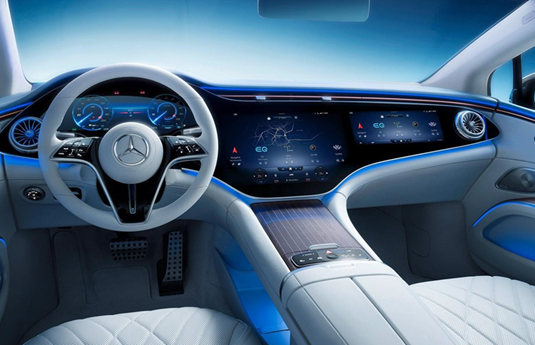
Source: Internet
The IM L7, which is planned to be mass-produced in 2022, is equipped with a 39-inch smart scenario screen and a 12.8-inch AMOLED center console screen. The 39-inch screen is composed of two joint screens, which can be raised and lowered separately with multiple display modes and allow the content to be switched without boundaries.
Smart Cockpit of IM L7
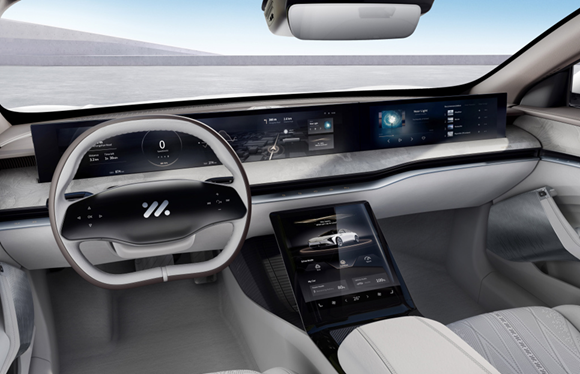
Source: Internet
Driven by high-definition mobile phone displays, consumers have more views on the resolution of automotive displays. Low-resolution displays can no longer meet the needs of the current users. Automotive displays tend to feature higher resolution, higher contrast, wider field of view, more optical indicators, and faster response. In the BMW iX scheduled to be launched at the end of 2021, the new iDrive 8 will come with horizontal curved dual screens: a 12.3-inch LCD cluster screen and 14.9-inch IVI screen (the angle is slightly inclined towards the driver). BMW says screens used in the new system will have a pixel density of 206 pixels per inch (PPI).
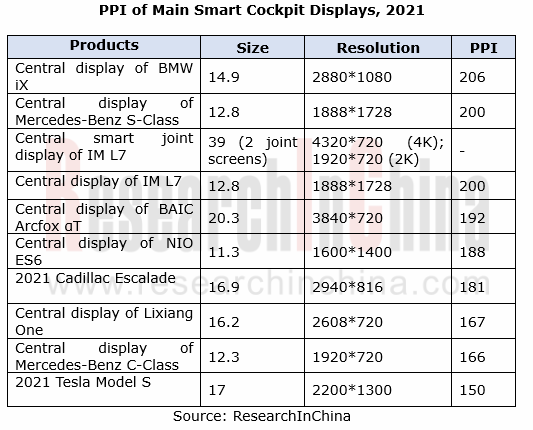
HMI capabilities develop from functional perception interaction to cognitive and active interaction
The HMI UI interface design for automobiles is changing on the basis of practical functions. With more and more functions, smart cars are getting cleverer, and the underlying data is more and more abundant. In the future, interface interactions will be more concise, 3D intuitive, younger, transparent, digitized, and symbolized, flattened and the like. In June 2020, Banma SmartDrive released the Venus Intelligent System whose UI interface adopts the design concept of A-B parallel worlds. World A takes a "map as a desktop", while World B uses a waterfall layout. Users can intuitively find commonly used functions on the interface, and even set the display interface as what they want.
Venus Intelligent System of Banma SmartDrive - AB Worlds
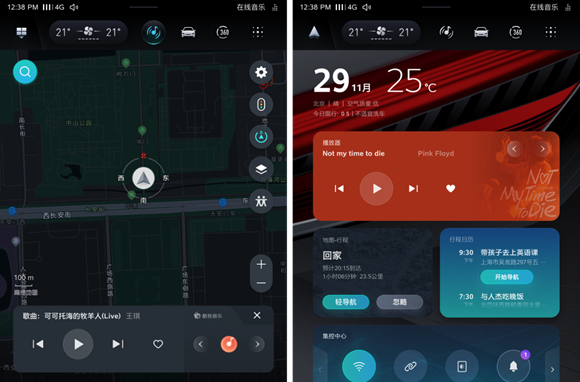
Source: Banma SmartDrive
MBUX Hyperscreen can display the desired personalized functions for users on the main interface of the central screen at an appropriate time, enabling "zero-layer" operation without scrolling or turning pages, bringing relaxed and intimate HMI experience.
"Zero-layer" Interactive Interface of Mercedes-Benz MBUX Hyperscreen
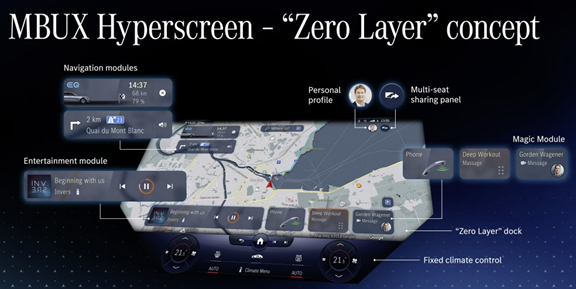
Source: Internet
Innovation and breakthroughs in UI interface design are inseparable from the development of HMI design tools. In terms of HMI design and development tools, many companies have released the latest products. Lately, HMI design and development tools feature multiple platforms, multiple algorithms, reusable software framework, 3D interface design, etc. In addition, with the creation of the third space of the smart cockpit and the continuous improvement of entertainment, technology HMI design companies such as web game companies like Eptic Games have dabbled in the automotive market.
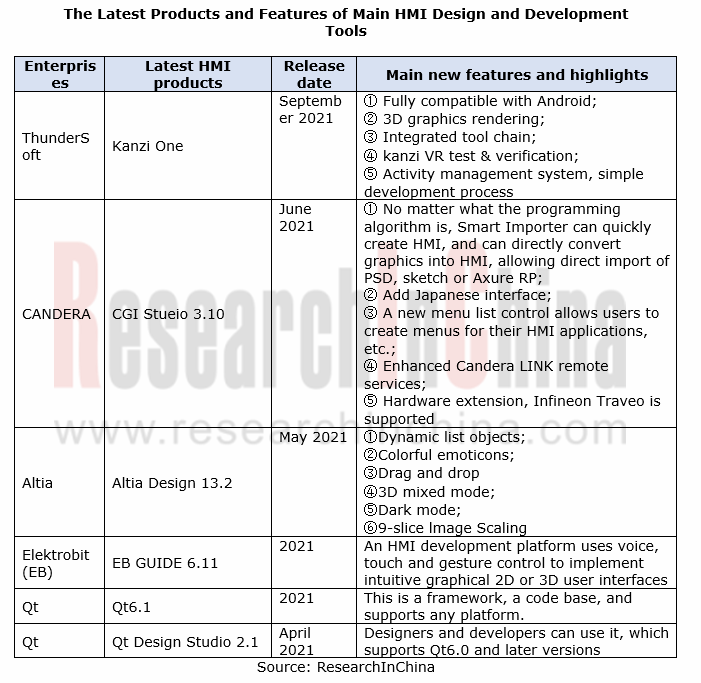
Through the fusion applications of AI, smart atmosphere lights, smart surface materials, fragrance systems, smart seats and other products and technologies, voice, AI assistants, face recognition, gestures, face, fingerprint, vital signs detection and other HMI technologies and models have been available in cars. The smart cockpit has certain HMI experience and scenario-based capabilities, and the cockpit scenario interaction is more intelligent, emotional, and humane. HiPhi X, which was mass-produced and delivered in 2021, can recognize the driver's expression, voice, heart rate, blood oxygen, blood pressure, breathing rate, etc. through 52 biosensors, and then adjust music and temperature, or take over the vehicle in dangerous situations.
At CES 2021, Samsung exhibited a digital cockpit equipped with Automotive Samsung Health, which analyzes passengers’ health status before boarding by utilizing a combination of cameras and wearable and mobile devices installed in the vehicle. In the car, it also regularly monitors passengers’ stress levels and will adjust the vehicle’s lighting, scent, or music in an effort to help them relax.
2021 Samsung Digital Cockpit with Automotive Samsung Health
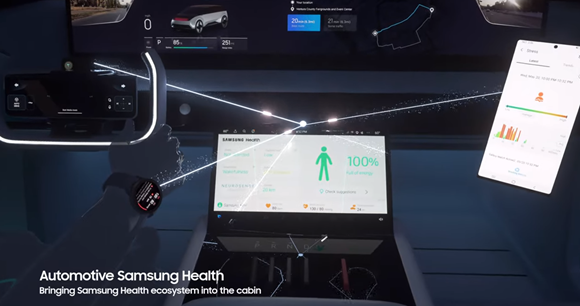 Source: Internet
Source: Internet
With the HMI design concept focusing on "user experience", HMI is developing from basic functional perception interaction to cognitive and active interaction through AI, in-car and out-of-car perception technologies.
Smart cockpits realize custom programming through SOA software
Since smart cockpits are designed as per human-oriented user experience, personalization will become a major development trend of smart cockpits in the future. In addition to the basic personalized custom settings such as the initial IVI system and buttons, the software architecture can help realize the personalized custom settings of multiple scenarios in the car. For example, the WM W6, which was launched at the Shanghai Auto Show in 2021, WM W6 realizes personalized combinations and settings of scenarios based on SOA software and through APP custom programming.
Custom Scenario Programming Card for WM W6
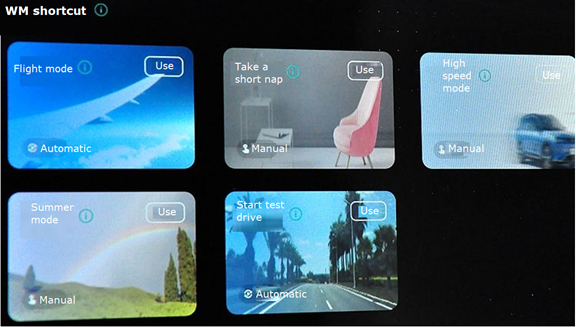
Source: WM
China Automotive Lighting and Ambient Lighting System Research Report, 2025
Automotive Lighting System Research: In 2025H1, Autonomous Driving System (ADS) Marker Lamps Saw an 11-Fold Year-on-Year Growth and the Installation Rate of Automotive LED Lighting Approached 90...
Ecological Domain and Automotive Hardware Expansion Research Report, 2025
ResearchInChina has released the Ecological Domain and Automotive Hardware Expansion Research Report, 2025, which delves into the application of various automotive extended hardware, supplier ecologic...
Automotive Seating Innovation Technology Trend Research Report, 2025
Automotive Seating Research: With Popularization of Comfort Functions, How to Properly "Stack Functions" for Seating?
This report studies the status quo of seating technologies and functions in aspe...
Research Report on Chinese Suppliers’ Overseas Layout of Intelligent Driving, 2025
Research on Overseas Layout of Intelligent Driving: There Are Multiple Challenges in Overseas Layout, and Light-Asset Cooperation with Foreign Suppliers Emerges as the Optimal Solution at Present
20...
High-Voltage Power Supply in New Energy Vehicle (BMS, BDU, Relay, Integrated Battery Box) Research Report, 2025
The high-voltage power supply system is a core component of new energy vehicles. The battery pack serves as the central energy source, with the capacity of power battery affecting the vehicle's range,...
Automotive Radio Frequency System-on-Chip (RF SoC) and Module Research Report, 2025
Automotive RF SoC Research: The Pace of Introducing "Nerve Endings" such as UWB, NTN Satellite Communication, NearLink, and WIFI into Intelligent Vehicles Quickens
RF SoC (Radio Frequency Syst...
Automotive Power Management ICs and Signal Chain Chips Industry Research Report, 2025
Analog chips are used to process continuous analog signals from the natural world, such as light, sound, electricity/magnetism, position/speed/acceleration, and temperature. They are mainly composed o...
Global and China Electronic Rearview Mirror Industry Report, 2025
Based on the installation location, electronic rearview mirrors can be divided into electronic interior rearview mirrors (i.e., streaming media rearview mirrors) and electronic exterior rearview mirro...
Intelligent Cockpit Tier 1 Supplier Research Report, 2025 (Chinese Companies)
Intelligent Cockpit Tier1 Suppliers Research: Emerging AI Cockpit Products Fuel Layout of Full-Scenario Cockpit Ecosystem
This report mainly analyzes the current layout, innovative products, and deve...
Next-generation Central and Zonal Communication Network Topology and Chip Industry Research Report, 2025
The automotive E/E architecture is evolving towards a "central computing + zonal control" architecture, where the central computing platform is responsible for high-computing-power tasks, and zonal co...
Vehicle-road-cloud Integration and C-V2X Industry Research Report, 2025
Vehicle-side C-V2X Application Scenarios: Transition from R16 to R17, Providing a Communication Base for High-level Autonomous Driving, with the C-V2X On-board Explosion Period Approaching
In 2024, t...
Intelligent Cockpit Patent Analysis Report, 2025
Patent Trend: Three Major Directions of Intelligent Cockpits in 2025
This report explores the development trends of cutting-edge intelligent cockpits from the perspective of patents. The research sco...
Smart Car Information Security (Cybersecurity and Data Security) Research Report, 2025
Research on Automotive Information Security: AI Fusion Intelligent Protection and Ecological Collaboration Ensure Cybersecurity and Data Security
At present, what are the security risks faced by inte...
New Energy Vehicle 800-1000V High-Voltage Architecture and Supply Chain Research Report, 2025
Research on 800-1000V Architecture: to be installed in over 7 million vehicles in 2030, marking the arrival of the era of full-domain high voltage and megawatt supercharging.
In 2025, the 800-1000V h...
Foreign Tier 1 ADAS Suppliers Industry Research Report 2025
Research on Overseas Tier 1 ADAS Suppliers: Three Paths for Foreign Enterprises to Transfer to NOA
Foreign Tier 1 ADAS suppliers are obviously lagging behind in the field of NOA.
In 2024, Aptiv (2.6...
VLA Large Model Applications in Automotive and Robotics Research Report, 2025
ResearchInChina releases "VLA Large Model Applications in Automotive and Robotics Research Report, 2025": The report summarizes and analyzes the technical origin, development stages, application cases...
OEMs’ Next-generation In-vehicle Infotainment (IVI) System Trends Report, 2025
ResearchInChina releases the "OEMs’ Next-generation In-vehicle Infotainment (IVI) System Trends Report, 2025", which sorts out iterative development context of mainstream automakers in terms of infota...
Autonomous Driving SoC Research Report, 2025
High-level intelligent driving penetration continues to increase, with large-scale upgrading of intelligent driving SoC in 2025
In 2024, the total sales volume of domestic passenger cars in China was...